- Macro-propagation of Tree species
Macro-propagation practices developed for some of the valuable tree species through shoot cuttings. Standardized macro-propagation practices for some of the important species are summarized in table below –
|
Species
|
Technique
|
Treatment
|
Treatment duration
|
Rooting ability
|
Reference
|
|
Dalbergia sissoo
|
Shoot cuttings of 10-12 years trees
|
IAA 100ppm
|
24 hrs basal dip
|
90%
|
Ansari et al, 1995
|
|
Azadirachta indica
|
Shoot cuttings of 10-12 years trees
|
IBA 1000ppm
|
Quick basal dip
|
80%
|
Palanisamy et al., 1998
|
|
Pongamia pinnata
|
Shoot cuttings of 10-12 years trees
|
IBA 800 ppm
|
15 hrs basal dip
|
100%
|
Palanisamy et al., 1998
|
|
Tectona grandis
|
Shoot cuttings of 15-20 years trees
|
IBA 400 ppm + Thiamine 400 ppm
|
24 hrs basal dip
|
40%
|
Ansari et al., 2002; Singh et al., 2005
|
|
Gmelina arborea
|
Shoot cuttings of 4-5 years trees
|
0.5mM IBA at 5.5 pH
|
4 hrs basal dip
|
50%
|
Pramod Kumar et al., 2011
|
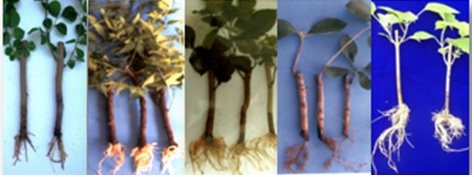
Dalbergia sisssoo; Azadirachta indica; Pongamia pinnata; Tectona grandis; Gmelina arborea
2. Measurement of Root surface area
A method based on the negative adsorption of NO2- has been developed. The method utilizes very dilute solution of nitrite which spreads as an aqueous thin layer on root surface. This nitrite is desorbed in water and estimated colorimetrically employing colour reaction of nitrite with diazo-coupling reagents, sulphaniamide and N-(1-naphthyl)-ethylene dihydrochloride. The concentration of the nitrite desorbed from the surface of the root pieces of reference plants (Acacia catechu, Eucalyptus camaldulensis and Leucaena leucocephala) exhibited very strong positive correlation (p < 0.001) with their surface area. The regression equations obtained for the three reference roots at 0.05M, 0.10M and 0.15M aqueous sodium nitrite solution employed to compute root surface area of 3 month old seedlings of six other tree species for verification.
Regression equation for 0.05M NaNO2 solution: Y=7.42 + 162.50 x
Regression equation for 0.10M NaNO2 solution: Y=2.73 + 158.26 x
Regression equation for 0.15M NaNO2 solution: Y=2.84 + 123.28 x
Where, Y=Root surface area (cm2) and x = Desorbed nitrite i.e O.D at 540nm
Reference:
Ansari, S.A., Pramod Kumar and B.N. Gupta (1995) Root surface area measurements based on adsorption and desorption of nitrite. Plant and Soil, 175:133-137.
3. Carbonic anhydrase for determining photosynthetic capacity in Teak genotypes
Carbonic anhydrase (CA) which catalyzes the reaction CO2 + H2O = HCO3 + H+ represent 1-2% of total soluble protein in leaves of C3 plants. It helps in carbon sequestration in woody perennials and may be used as a biochemical marker for photosynthetic capacity and productivity. Carbonic anhydrase activity was significantly and positively correlated with photosynthetic rate in general populations of 10 years old trees (p<0.005) contributing 41% to photosynthesis. Similarly 10 out of 21 5-year old teak half sib families showed a significant positive correlation between CA activity and photosynthetic rate ( r2 =0.34 to 0.88).
Reference:
Tiwari, A.; Pramod Kumar, Chwhaan, P.H.; Singh, S. and Ansari, S.A. (2006). Carbonic anhydrase in Tectona grandis: kinetics, stability, isozyme analysis and relationship with photosynthesis. Tree Physiology 26: 1067-1073.
- Relationship between endogenous auxin (IAA) and adventitious rooting in tree species :
Recorded a weak non-significant relationship between endogenous Indole-3-acetic acid (IAA) and adventitious rooting in Dalbergia latifolia and Dalbergia sissoo explains indirect role of endogenous IAA in the process of adventitious rhizogenesis in tree species.
References:
- Pramod Kumar, Archna Chaturvedi and Vivek Vaishnav (2022) Relationship between endogenous auxin (Indole-3-acetic acid) and adventitious rooting in Dalbergia species (D. latifolia and D. sissoo) of different rooting ability. Journal of Tropical Forest Science 34(2):149-158.
- Pramod Kumar, Pawan Kumar Patel and M.K. Sonkar (2022) Propagation through juvenile shoot cuttings in difficult-to-root Dalbergia latifolia – examining role of endogenous IAA in adventitious rooting. Plant Physiology Reports 27(2): 242-249. https://doi.org/10.1007/s40502-022-00664-x
v. Conservation Strategy for Boswellia serrata Roxb. in M.P. and Chhattisgarh
Based on genetic diversity analysis through RAPD and ISSR markers developed conservation strategy for Boswellia serrata, an endangered species -
- In situ conservation: This approach would be suitable for the areas where genetic composition of a population is not closely related to other populations viz. Balaghat, Jabalpur, Gwalior, Khandwa and Sheopur in M.P. and Dhamtari, Narayanpur and Sarguja in Chhattisgarh.
- Ex situ conservation: This approach will be suitable in areas of low density of the species and populations which are reasonably related to populations elsewhere, genetically like Chhindwara-Chhatarpur, Damoh-Mandla, Gwalior-Sheopur/Shivpuri, Panna-Shivpuri/Rewa
Combined analysis for 15 populations of M.P. and Chhattisgarh exhibited that Sarguja, Dhamtari and Narayanpur are genetically relatives of Jabalpur, Balaghat and Chhatarpur in decreasing order and therefore, recommended for conservation of the species across the state boundaries.
References :
- Pramod Kumar (2017) Boswellia serrata Roxb.: Status and Conservation. TFRI/Technical Bulletin-02/2017. 1-16 pp.
- Vivek Vaishnav, Shashank Mahesh and Pramod Kumar (2019) Assessment of genetic structure of the endangered forest species Boswellia serrata Roxb. population in central India. Journal of Tropical Forest Science 31(2): 200-210.
4. User friendly macro-propagation of difficult-to-root Dalbergia latifolia Roxb.
Achieved 30% rooting success (rooted hardened plants) which is much higher than the earlier reports of 10-12% rooting in difficult-to-root Dalbergia latifolia. Use of juvenile shoot cuttings obtained through hedging of 6-10 years old progenies of selected trees, 18-20 hrs basal dip treatment of 5.0 mM IAA + 1.0 mM Boric Acid, propagation in soil mix in polybags and in ambient temperature and humidity in shade net house makes the technique user friendly.
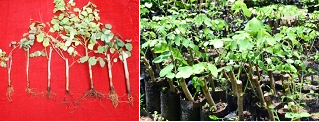
References :
- Pramod Kumar, Pawan Kumar Patel and M.K. Sonkar (2022) Propagation through juvenile shoot cuttings in difficult-to-root Dalbergia latifolia – examining role of endogenous IAA in adventitious rooting. Plant Physiology Reports 27(2): 242-249. https://doi.org/10.1007/s40502-022-00664-x
- Pramod Kumar, Pawan Kumar Patel and Vimal Pandro (2023) User friendly propagation technique for quality plant production of Dalbergia latifolia (Roxb.) for ecological sustenance. Pp 140-153. In: Clonal Forestry (eds.) Tomar A. and Singh S.
- प्रमोद कुमार, मुकेश कुमार सोनकर एवं पवन कुमार पटेल (२०२१) काला शीशम (डलबर्जिया लेटीफ़ोलिया ) के उच्च गुणवत्ता युक्त पौधे तैयार करने की कायिक प्रजनन विधि. वन अनुसंधान ई पत्रिका – ५(1): २३-२५.
5. Propagation of Bambusa tulda and B. nutans using culm-branch cuttings
Season and cuttings’ thickness is influential in determining rooting ability in culm-branch cuttings of Bambusa tulda and Bambusa nutans. Culm-branch cuttings planted during spring-summer in March and sampled after 60 days reveals 63.39% and 72.68% rooting ability respectively in ≤2.0 cm diameter (thin) and >2.0cm diameter (thick) cuttings of Bambusa tulda and 73.60% and 69.02% rooting ability respectively in thin and thick cuttings of Bambusa nutans. Rooting ability of branch cuttings decline in rainy season followed by autumn-winter in two diameter classes of both species. Strong relationship (R2 ≈ 1) with the season in both diameter classes was observed.
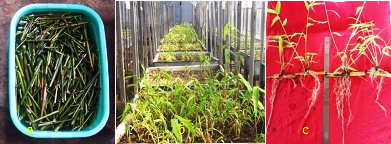
Propagation through culm-branch cuttings in Bambusa tulda and B. nutans. (a) Hormone treatment (b) Sprouted cuttings (c) Rooted cuttings
References :
- Pramod Kumar, J.P. Mishra, M.K. Sonkar, Y. Mishra and Fatima Shirin (2021) Relationship of Season and Cuttings’ Diameter with Rooting Ability of Culm-Branch Cuttings in Bambusa tulda and Bambusa nutans. Journal of Plant Growth Regulation https://doi.org/10.1007/s00344-021-10461-9
- Pramod Kumar, M.K. Sonkar, P.K. Rana, J.P. Mishra and Fatima Shirin (2019) Macropropagation of Bamboos: Principles and Practices. In Training Manual: GSDP-Propagation and Management of Bamboo. 62-69pp.
6. Establishment of field trial of Dalbergia latifolia
Established a field trial of seedlings and cuttings’ raised plants of Dalbergia latifolia in 2018. Cuttings’ raised plants exhibited significantly higher growth characters viz. height, number of primary branhes and foliar diameter over seedlings after 30 months of planting.
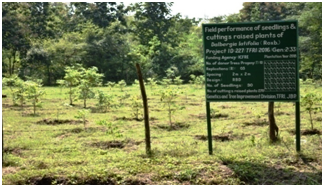
7. Selection of Plus Trees of Teak (Tectona grandis):
Marked 191 plus trees of Teak (Tectona grandis) in 4 states (M.P.-118, Chhattisgarh-43, Maharashtra-17, Odisha-13) based on phenotypic traits following check trees method.
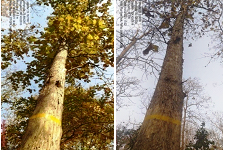
Reference :
- Pramod Kumar, P.K. Rana, naseer Mohammad, Fatima Shirin and Yogeshwar Mishra (2023) Candidate Plus Trees of Teak (Tectona grandis Linn.f.) selected in central India. TFRI Technical Bulletin/03/2023/40
8. Establishment of Progeny trial of Teak (Tectona grandis) :
Established a Progeny trial of Teak (Tectona grandis) in 2019 representing 29 families (M.P.-05, Chhattisgarh-08, Maharashtra-08, Odisha-08).
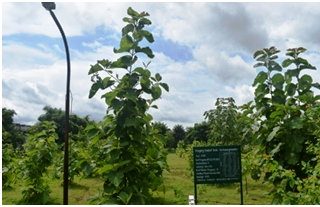
9. Establishment of Seedling Seed Orchard (SSO) of Teak (Tectona grandis):
Established a Seedling Seed Orchard (SSO) of Teak (Tectona grandis) in 2019 representing 33 families (M.P.-13, Chhattisgarh-10, Maharashtra-10).
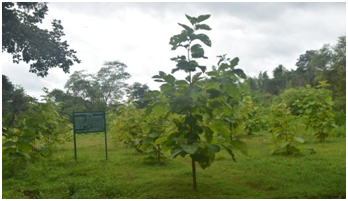
10. Establishment of Germplasm bank of Teak (Tectona grandis):
Established a Germplasm Bank of Teak (Tectona grandis) in 2020 representing 31 Accessions (M.P.-12, Chhattisgarh-09, Maharashtra-05, Odisha-05).
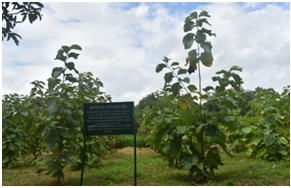
11. Establishment of Clonal Seed Orchard (CSO) of Teak (Tectona grandis):
Established a Clonal Seed Orchard (CSO) of bud grafted Teak (Tectona grandis) in 2021 representing 15 clones from 5 agro-climatic zones of Madhya Pradesh.
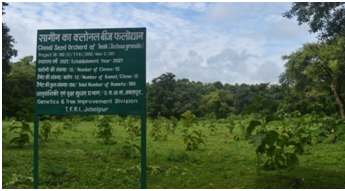
12. Micropropagation of Bamboo species
TFRI has developed micropropagation protocols of nine indigenous bamboo species (Bambusa bambos, B. nutans, B. nana, B. polymorpha, B. tulda, B. vulgaris var. green, Dendrocalamus giganteus, D. membranaceus, and D. strictus) and one exotic edible species (Dendrocalamus asper) through tissue culture. Collection and sterilization of explants, culture establishment, shoot multiplication and root induction and finally hardening and acclimatization has been standardized. Single nodal segments with axillary buds collected from field growing clumps (7-10 year old) has been used as explant for culture establishment. The explants were sterilized with 0.1 – 0.2 % mercuric chloride and shoot multiplication was carried out on semi-solid or liquid culture (usually MS) medium enriched with 1 – 7 mg -1 I BA. A culture cycle of 15 – 30 days produced 2 – 15 shoots, which were induced to rooting on MS medium enriched with 3 – 5 mg-1 l IBA, NAA or coumarin. The rooting success varied from 50 – 90 %. The plantlets were gradually hardened from culture room to shade house via mist chamber. The hardened plantlets had 80 – 100 % field survival. Standardized micropropagation methods for some of the important bamboo species are summarized in Table1 and 2.
Table 1: In vitro shoot multiplication in various bamboo species
|
Species
|
Medium
|
Phytohormones
|
Multiplication rate (fold)
|
References
|
|
Bambusa nutans
|
MS liquid
|
7 mgl-1 BA + 0.5 mgl-1 IAA
|
2-3
|
Shirin et al., 2008
|
|
Bambusa tulda
|
MS liquid
|
2.5 mgl-1 BA
|
2
|
Mishra et al.,2008
|
|
Bambusa vulgaris var. green
|
MS semisolidliquid
|
3 mgl-1 BA
|
3-4
|
Shirinet al., 2003
|
|
Bambusa nana
|
MS semisolidliquid
|
1 mgl-1 BA
|
2-3
|
Shirin and Arya, 2003
|
|
Bambusa polymorpha
|
MS semisolidliquid
|
4 mgl-1 BA
|
2-3
|
Aryaet al., 2005
|
|
Bambusa bambos
|
MS semisolid
|
3 mgl-1 BA
|
4-5
|
Arya and Sharma, 1998
|
|
Dendrocalamus strictus
|
MS liquid
|
3 mgl-1 BA+ 0.5 ml-1vipul
|
4-5
|
Mishra et al.,2001
|
|
Dendrocalamus asper
|
MS semisolidliquid
|
3 mgl-1 BA
|
15-20
|
Aryaet al., 1997
|
|
Dendrocalamus membranaceus
|
MS semisolidliquid
|
5 mgl-1 BA
|
10-12
|
Aryaet al., 2002
|
|
Dendrocalamus giganteus
|
Liquid
|
4 mgl-1 BA
|
3-4
|
Aryaet al., 2006
|
Table 2: In vitro adventitious rhizogenesis in various bamboo species
|
Species
|
Medium
|
Phytohormones
|
Rooting %
|
|
Bambusa nutans
|
MS liquid
|
5 mgl-1IBA
|
60-70
|
|
Bambusa tulda
|
MS liquid
|
5.84 mgl-1 Coumarin
|
98
|
|
Bambusa vulgaris var. green
|
MS semisolid liquid
|
5 mgl-1 NAA
|
80-90
|
|
Bambusa nana
|
MS semisolid liquid
|
5 mgl-1IBA
|
70-80
|
|
Bambusa polymorpha
|
MS semisolid liquid
|
4 mgl-1 NAA
|
70-80
|
|
Bambusa bambos
|
MS semisolid
|
3 mgl-1 NAA
|
80-85
|
|
Dendrocalamus strictus
|
MS liquid
|
3 mgl-1 NAA+ 2.5 ml-1 rice bran extract
|
50-60
|
|
Dendrocalamus asper
|
MS semisolid liquid
|
3 mgl-1 NAA
|
90-95
|
|
Dendrocalamus membranaceus
|
MS semisolid liquid
|
2 mgl-1 NAA
|
80-90
|
|
Dendrocalamus giganteus
|
Liquid
|
5 mgl-1 IBA+0.01 mgl-1BA
|
70-80
|
Impact of technology: Mass production of quality planting material. The acclaimed work on tissue culture of bamboos resulted in award of a patent entitled “A protocol for micropropagation of bamboos from explants” (patent no. 207870) on 29.06.2007 by the Controller of Patents, Mumbai. Demonstration trial of tissue culture raised bamboos has been established at the TFRI campus.
Fig. 1: In vitro shoot multiplication (a) B. nutans, (b) B.tulda, (c) B. vulgaris var. green, (d) B. nana.
Fig. 2: The in vitro adventitious root formation; (a) B. nutans, (b) B.tulda, (c) B. vulgaris var. green (d) B. nana.
Tissue culture raised plants of bamboos
13. Macropropagation of various Bamboo species through culm-cuttings
Culm cuttings of Bambusa vulgaris var. green, B. tulda, B. nutans and B. balcooa were collected from clumps growing in the field. For B. vulgaris, B. tulda and B. nutans smaller size cuttings of 30-40 cm length and about 1-2 cm or 2-3 cm or 3-4 cm diameter with single nodes were prepared and used for propagation. These culm cuttings were completely dipped in IBA solution (200 ppm) for 24 hours. For B. balcooa bigger size cuttings of 70-80 cm length and about 4-5 cm diameter with double nodes were used for propagation. Small cavities were made on the culm cuttings and 1000 ppm IBA solution was poured in these cavities. The cavities were covered with tape and the cuttings were planted in the sand bed. Sprouting was initiated after one week and optimum rooting was achieved in four weeks under controlled environmental conditions of mist chamber i.e., temperature about 30°C, relative humidity 70% and intermittent misting for B. vulgaris, B. tulda and B. nutans. For B. balcooa sprouting initiated after two week and optimum rooting was achieved in five weeks. Rooting percentage ranged from 65 % to 95 % in different species and in different diameter classes as depicted in the table 1. The culm cuttings produced maximum adventitious rooting when planted during the months of April-May.
Table 1: Adventitious rooting obtained in culm cuttings of various Bamboo species through Macropropagation
|
Species
|
Time period
|
Diameter of cuttings (cm)
|
Auxin Treatment (ppm)
|
Rooting (%)
|
|
Bambusa vulgaris var. green
|
April- May
|
- – 2
|
200
|
85 – 95
|
|
B. tulda
|
April
|
2 – 3
|
200
|
80-85
|
|
B. nutans
|
April
|
1 – 2 and 2 – 3
|
200
|
70 – 75
|
|
B. balcooa
|
April
|
4 – 5
|
1000
|
60-65
|
Beneficiaries of the technology: State Forest Departments, Plantation companies, Research organizations, Farmers, Bamboo nursery owners.
Impact of technology: Mass production of quality bamboo plants. A large number of plants have been produced and supplied to various end users, consequently earning revenue for the institute/ICFRE.
Macropropagation of Bambusa vulgaris var. green through culm cuttings
Macropropagation of Bambusa balcooa through culm cuttings
Macropropagation of Bambusa tulda through culm cuttings
Macropropagation of Bambusa nutans through culm cuttings
14. Studies on variations with rerspect to in vitro azadirachtin production in Azadirachta indica A. Juss.
Azadirachtin was isolated and quantified from seeds, in vitro shoots and callus cultures using solvent extraction method. Highly significant variation with respect to azadirachtin content in seed samples, in vitro shoot samples and callus culture samples was observed. Maximum azadirachtin was produced in the seeds of Gwalior (0.882 %) which was on par with azadirachtin content in seeds of Chhatarpur, Katni, Sihore, Shahdol and Chhindwara. Maximum azadirachtin in in vitro shoots was produced in the cultures of Gwalior (0. 218 %) which was statistically on par with Sihore (0.176 %).
In vitro shoot cultures of Azadirachta indica
15. Collection of germplasm of Madhuca indica for identification of best sources in Chhattisgarh through phytochemical evaluation
Mahua trees were selected from five girth classes, viz., 61-90 cm, 91-120 cm, 121-150 cm, 151-180 cm and over 181cm from three agroclimatic zones of Chhattisgarh. Maximum sugar (79.53 %) was observed in flowers of Sarguja locality followed by flowers of Jagdalpur locality (77.08 %). The girth class of trees also significantly affected for sugar content of flowers. Maximum sugar (73.46%) was observed in the trees of 121-150 cm GBH followed by the trees of 151-180 cm GBH (72.90 %). Oil content was obtained in the range of 9.95 to 53.04 %. Maximum oil content was obtained in seeds of Jashpur (50.85 %) population, followed by Sarguja (45.36 %). Significant positive correlation was recorded between oil content and saponin content in seeds of mahua. The two localities of Sarguja and Jagdalpur yielding more sugar in their flowers can be utilized for a number of uses in food industry and pharmaceutical industry. Similarly, localities yielding more oil content in seeds, viz., Jashpur and Sarguja can be used for production of mahua butter which is used in soap industry and also as edible oil.
16. Genetic Improvement and micropropagation of Dalbergia latifolia
From the four central Indian states CPTs of Dalbergia latifolia were located. Largest number of CPTs were found in Allapalli Range (Chandrapur Forest Division) in Maharashtra followed by Tamia Range (Chhindwara Forest Division) in Madhya Pradesh. Maximum somatic embryo formation was obtained on 0.5 mg l-1 2, 4-D (56%) during somatic embryogenesis through immature embryos collected 90 days after flowering. Biochemical changes during different stages of embryogenesis were evaluated. Progeny trial of the vulnerable species Dalbergia latifolia was established at Jabalpur.
Impact: Technical Bulletin on Dalbergia latifolia was prepared and disseminated to stakeholders. The progeny trial will be used for evaluation and selection of better performing families.
Somatic embryos formed on cotyledons of seeds collected 90 days after flowering in Dalbergia latifolia on MS medium supplemented with different concentrations of 2,4-D and Kinetin.
17. Clonal Fidelity Testing Services
Clonal Fidelity Testing Services was provided to Chhattisgarh State Forest Department, Raipur for eucalyptus clonal stock procured under Hariyali Prasar Yojna during 2015-16, 2016-17, 2017-18 and 2018-19 (four years). Testing was done using molecular markers. The task was accomplished in a timely and phased manner and helped in revenue generation (Rs. 42 lakhs approx.) for the institute and ICFRE. It has not only earned revenue for the institute but also demonstrated the application of molecular marker technology for quality control in social forestry plantations. Further, testing services for checking the genetic fidelity of tissue culture raised bamboo plants was provided to the Chhattisgarh Forest Department.
Eucalyptus plants and leaves forwarded by the DFO, South Kondagaon Division, South Kondagaon (C.G).
18. Germplasm Bank of bamboos
Germplasm Bank of bamboos of six species viz, Bambusa tulda, B. vulgaris, B. bambos, B. balcooa, B. nutans and Dendrocalamus strictus was established at TFRI, Jabalpur.
Germplasm bank of different Bamboo species at TFRI, Jabalpur
19. Development and release of varieties of Rauvolfia serpentina (Sarpagandha)
Rauvolfia serpentina (L.) Benth. (Family Apocynaceae) is an indigenous important medicinal plant distributed in India and many other tropical countries of Asia. The roots contain 50 indole alkaloids including the therapeutically important reserpine. Germplasm Bank of Sarpagandha has been established having collection from 11 states, viz., Chhattisgarh, Madhya Pradesh, Maharashtra, Orissa, Uttar Pradesh, Kerala, Karnataka, Tamil Nadu, Goa, Himachal Pradesh and Uttrakhand. The phenotypic stability of 23 genotypes or R. serpentina were compared with two checks viz., RS-1(JNKVV, Indore) and CIM-Sheel (CIMAP, Lucknow) for reserpine content in root and related traits in three different locations. Finally, two varieties of R. serpentina TFRI-RS1 and TFRI-RS2 were released by National Variety Release Committee, New Delhi in February 2017 from Genetics and Tree Improvement Division as improved varieties for high reserpine, total alkaloid and root yield. The variety TFRI-RS1 gives high root yield whereas TFRI-RS2 contains high alkaloid and reserpine. Both the varieties can be utilized for cultivation.
Varieties of Rauvolfia serpentine (TFRI RS-I and TFRI RS-II)
Impact of technology: These varieties can be planted by farmers and other end users for increase in alkaloid content.
20. Collection and conservation of Litsea glutinosa Lour. (Maida Lakri) from Madhya Pradesh and Chhattisgarh
Litsea glutinosa (Lour.) C.B. Rob., one of the important non-timber forestry species in Central India, is represented by highly fragmented populations and has been drastically reduced for the last 40 years, promulgating government ban on its extraction. For the first time, we conducted detailed survey in MP-CG and investigated morpho and molecular variation. Our investigation suggests that: (1) high levels of genetic diversity exist primarily within rather than between populations of L. glutinosa, (2) unsustainable extraction has led to widespread population fragmentation rather than genetic factors, and (3) only four genetic clusters of L. glutinosa exist in central India.
Under this work, we have established field germplasm was established at TFRI campus, Jabalpur. Also, one block plantation of 400 plants was established at FRC-SD, Chhindwara. Propagation protocol through seeds was standardized and advisory for conservation of this valuable species communicated to MP and CG forest departments.
Photo. Germplasm bank of L. glutinosa Lour. (Maida Chaal)
21. Inferring genetic diversity and population structure of National Teak Germplasm Bank
In this study, we carried out a genetic diversity analysis among 238 accessions from 11 populations (representing eleven states) maintained in National Teak Germplasm Bank (NTGB) using SSR markers. Analysis of molecular variance (AMOVA) showed variations of 85% within and 15% among populations. The entire collections were clustered into two groups, confirmed by Bayesian model-based structure analysis. An analysis of population Q matrix revealed that the proportion of membership for few accessions were not distinct. Accessions from Odisha, Madhya Pradesh, Uttar Pradesh and Gujarat constituted one cluster whereas, Tamil Nadu & Kerala formed second cluster. Possible reasons for the high genetic diversity and heterozygosity within this species are discussed and our results have established that introduction of genetic materials from country-wide sources with larger sample size may broaden the genetic base and strategy of conservation programme at NTBG. Thus, molecular markers can aid in making the decision to include or exclude any populations for conservation based upon well-supported and comprehensive data on the variability and genetic similarity among populations.
Bar plot showing two genetic pools [(a) sorted as per Q, (b) as per population ID] in teak accessions conserved at NTGB based on Bayesian model based STRCTURE analysis. Each accession is divided in to a number of hypothetical subpopulations (K = 1 to 14), most divergent sub-populations were obtained at K = 2
22. Plantation of bamboo in farmer’s field
Six bamboo plantations have been established at Naugaja, Chingrola, Bharhut, Kacharwar, Jabalpur and Kundum, MP in consultation with Orient paper Mill, Amlai. Observations were recorded in the bamboo plantations carried out in various farmers fields located at different villages (Naugaja, Chingrola, Bharhut, Kundam). Survival of 65- 75 % was recorded. Observations are being recorded on morphometric parameters viz., total number of culms, culm height and culm diameter, twice per year. All plantations were maintained by application of fertilizers, weeding and irrigation. The field trial of two different CPCs of six bamboo species (B. bambos, B. balcooa, B. tulda, B. nutans, B. vulgaris var. green and D. strictus) was maintained at Jabalpur with 93-97 % survival. Maximum culm height (4.3 m) was recorded in Bambusa vulgaris var. green (BV-GH-01 clump), followed by B. tulda (BT-Bot-Cl-1 clump). Pseudooxytenanthera stocksii has been planted in KVK, Umaria as an introductory trial. Macropropagation is being continued through culm cuttings and cavity method. In vitro shoot multiplication and rooting of Pseudooxytenanthera stocksii is being carried out.
Bamboo Plantation at farmer’s field at Bharhut, Umaria after 19 months of plantation
Species trial of Bamboos at Kundam in farmer’s field
23. Establishment of Bambusetum
Bambusetum was established with 50 bamboo species at TFRI, Jabalpur. Collection of different bamboo species was done from NE India, Kerala, Maharashtra, Odisha, Madhya Pradesh and Chattisgarh.
Impact: This is a unique collection of bamboos which is being visited by students, farmers, artisans and other stakeholders.
Bambusetum at TFRI, Jabalpur
24. Establishment of progeny trial of Gmelina arborea
Establishment of progeny trial in RBD design with four replications at 3m X 3m spacing in 1.24 acre land at TFRI, Jabalpur was completed. 28 half-sib families from different locations were planted.
Progeny trial of Gmelina arborea at TFRI, Jabalpur
25. Establishment of germplasm bank of Plumbago zeylanica and Celastrus paniculatus
Germplasm bank of plants of Plumbago zeylanica from 10 locations and plants of Celastrus paniculatus from 14 locations of Chhattisgarh was established at TFRI, Jabalpur.
Germplasm bank of Plumbago zeylanica and Celastrus paniculatus
26. Testing of Casuarina clones developed by IFGTB, Coimbatore in Madhya Pradesh
Established three multi-location trials of casuarina clones developed by IFGTB, Coimbatore in Madhya Pradesh in July-August, 2021. Each clonal trial consists four replications, 36 ramets per plot and 6 clones. Presently, average survival percentage is ranging from 45-55% in these trials. Systematic evaluation of Casuarina is taking place first time in central Indian conditions under AICRP-01 (Casuarina).
27. Testing of Eucalyptus clones developed by IFGTB, Coimbatore in Madhya Pradesh
Two adoptive clonal trials each consisting of 151 clones with six replications were established in Jabalpur forest division in 2020 and 2021, respectively with aim to identify the promising clones for MLT testing. These clones are developed by IFGTB, Coimbatore and testing is initiated under AICRP-4 (Eucalyptus).
28. Mopho-molecular and wood density variation in natural teak (Tectona grandis L.f.) from Central India
Although, central India is recognized as one of the major centre of genetic diversity, studies are very limited from this region compared to southern/peninsular region. Those available on country level were mostly based on ex-situ raised trials or plantations, considered few localities/individuals including very low and/or no representation from central India. Therefore, present investigation was undertaken in 13 agro-climatic zones having natural teak populations. Analysis of morphological data revealed that in the overall studied populations of T. grandis, tree height, clear bole height and girth at breast height ranged from 7.62 m to 38 m, 2.21 m to 32.0 m and 70.0 cm to 265.0 cm, respectively. Coefficient of variation was observed to be 24% for tree height, 41% for clear bole height and 27% girth at breast height. Populations from Chhattisgarh state recorded highest average values for tree height, clear bole height and GBH followed by Madhya Pradesh and Maharashtra. It is also observed that wood density ranged from 401.51-792.96 Kg/m3 with an average of 584.55 Kg/m3; fibre length ranged from 734.41– 1266.78 µm with an average of 987.03 µm; and fibre width ranged from 17.88– 33.33 µm with an average of 24.73 µm. Compared to morphological traits, wood traits have recorded considerably low coefficient of variation. Sambalpur (668.27 Kg/m3) recorded highest wood density followed by Khariar (660.42 Kg/m3). Investigation using microsatellite markers revealed high level of genetic diversity in the sampled populations of T. grandis.
Figure: (a) Glimpses of the field visits and data recording in Madhya Pradesh and Odisha. (b) Marking of sampled tree and extraction of wood core sample. Location: Jagdalpur forest division
29. Assessment of diversity of S. urens Roxb. for development of conservation strategy in Madhya Pradesh
Collected information about the populations of S. urens in Madhya Pradesh from working plans and surveyed potential areas from Khandwa, South Seoni, North Seoni, Jabalpur, Rewa, Chhatarpur, Tikamgarh, Jhabua, Shivpuri, Gwalior and Sheopur Forest Divisions. Recorded morphometric data along with GPS coordinates. Also recorded data on natural regeneration from these sites by laying out the sample plots. Overall, average tree height was recorded 8.68 m with range of 18 m and CV- 48%. Similarly, mean GBH was observed to be 128.05 cm with 64% CV. We observed that natural regeneration in this species is very low despite profuse flowering and fruiting. Mostly large, matured trees were found scattered on the hilltops and rocky crevices. In Tikamgarh (Bundelkhand), Khandwa (Nimar plains) and Dhar (Malwa Plateau), younger stems occupying hill tops and rocky plateau are also recorded. Experiment for screening of suitable potting medium for seed germination of S. urens was conducted. Based on final germination percentage and associated parameters, we found that sand is better medium compared to others as it gives highest germination percentage with faster rate resulting in saving of nursery resources viz., space, time and other inputs.
Field Surveys and data recording at Seoni and Rewa Forest Division
30. Establishment of Conservation plots/progeny trials
Two conservation plots of Litsea glutinosa (Maida lakri) and one of Buchanania lanzan (Chironji) were established in Chhindwara (West) Forest divisions of Madhya Pradesh. Details are as follows
|
Sl. No.
|
Species
|
Location
|
No of plants
|
|
1.
|
L. glutinosa
|
Dellakhari Range (P-104)
|
300
|
|
2.
|
L. glutinosa
|
Dellakhari Range
|
200
|
|
3.
|
B. lanzan
|
Dellakhari Range
|
Progenies of 12 CPTs
|
|
4.
|
L. glutinosa
|
Tamia Range
(*Plants were handed over to RFO, Tamia)
|
200*
|
Glimpses of the activities (Plantation / Distribution) undertaken for conservation of maida lakri
Glimpses of the progeny trial establishment of Chironji
31. Genetic Improvement of Madhuca longifolia
Total 460 phenotypically superior trees of Madhuca longifolia were selected on the basis of criteria of flower yield from 23 different locations of Chhattisgarh, Madhya Pradesh and Maharashtra. Scions were collected from 90 selected phenotypically superior trees from 18 locations and cleft grafting was carried out. Grafting success of 40-50 % was achieved. Vegetative Multiplication Garden has been successfully established with grafted plants of 34 genotypes of selected superior trees from different locations of Madhya Pradesh, Chhattisgarh and Maharashtra at TFRI campus (Lat. 230 5’ 54” N, Long. 790 59’ 20” E). 1500 seedlings have been produced. Leaflet entitled "Madhuca longifolia (Mahua): A Useful NTFP Species of Madhya Pradesh" has been published in English and Hindi. Studies are under progress for refinement of Mahua liquor.
Impact: Grafted Mahua will be planted in field and thus help in domestication of Mahua.
32. Tissue culture and establishment of field trials of tissue culture raised clones of Tectona grandis
In vitro stock cultures of the five clones of IFGTB, Coimbatore were multiplied and maintained on standardized culture medium viz., MS medium supplemented with 0.225 mgl-1BA and 0.215 mgl-1 Kinetin. Field trials using tissue culture raised plants have been established at eight locations in Maharashtra and Madhya Pradesh. In the teak trial at Bargi and Baghraji 55-60% survival was observed. Survival in the FDCM plantations in Maharashtra is in the range of 71- 91%.
Plantation of Tissue culture Raised Teak clones at Salekasa Range, Gondia, Maharashtra
Shoot multiplication in different clones: a) Teak clone -2, b) Teak clone- 3, c) Teak clone- 4 and d) Teak clone-5 Shoot multiplication in different clones: a) Teak clone -2, b) Teak clone- 3, c) Teak clone- 4 and d) Teak clone-5
33. Establishment of clonal trial of Gmelina arborea
Phenoyptically superior trees of Gmelina arborea were selected from various locations of Madhya Pradesh in forest areas and plantation. The different sites were Betul (Sonaghati), Chhindwada, Sidhi (Dodaki), Katni (Saraswahi), Damoh (Nohta, Sanga), Dindori (Shahpura, Choorai) and Jabalpur (Moiyanala, Barha). Attention was paid for selection of healthy trees free from disease and insect pests. 60 Candidate Plus Trees have been selected. Semi-hardwood cuttings were treated with different treatments (control, 100 ppm, 200 ppm, 500 ppm and 1000 ppm) of IBA and then planted in nursery. Maximum rooting (73.13 %) with maximum root number (6.22) and root length (6.21 cm) was achieved in the cuttings treated with 200 ppm IBA. Plants were also prepared through cleft grafting. Around 60-70 % success was achieved during grafting. Clonal trial has been established at TFRI, Jabalpur with 34 CPTs of 10 different locations viz., Shahpura, Moiyanala, Barha, Chaurai, Jabalpur, Bargi, Katni, Chhindwara, Sidhi and Singrauli of Madhya Pradesh.
Plants of Gmelina arborea in polybags and planted in the field
34. Plantation technique trials of Haldina cordifolia (Haldu)
Research on Haldina cordifolia for higher wood productivity is underway at ICFRE-TFRI, Jabalpur. In the month of July, 2023, two plantations of Haldina caordifolia (Haldu), one at Jagmandal Range, Mandla, Madhya Pradesh. and another one at Guru Ghasidas Vishwavidyalaya, Bilaspur, Chhattisgarh were established under the project. Seedlings were raised for these plantations from seeds of superior quality trees selected from three states of Central India - Madhya Pradesh, Maharashtra and Chhattisgarh. These plantations were carried out at two different spacings (3X3 m and 5X5 m) and two different pit sizes (30X30X30 cm and 45X45X45 cm). In next few months, growth performance of these seedlings will be checked.
